Star Citizen has had its fair share of controversy since the game was revealed in 2014 and a lengthy article sheds some light on its troubles.
With $125 million raised from backers, anyone would think that it would be easy for CIG to create Star Citizen. After talking to both Roberts and former employees, Kotaku discovered it’s been anything but easy for CIG. While we already know most of what’s in the article, there’s a few bits and pieces of interest.
Backers who have been following the game from the start will be aware of the ambitious stretch goals in the early days before they were stopped by CIG and Roberts admits it was a problem saying he, “didn’t want to keep doing stretch goals, because you’re just making stuff up that isn’t core to what you want.”
As well as stretch goals being a problem, there has been issues with finding the right staff at the right price which prompted Roberts to seek help from outside studios such Illfonic to work on Stat Marine. Illfonic ceased work on the project back in August 2015 and was moved in-house and much of the work created by Illfonic over two years was never used.
These outside studio contracts were seen as a temporary solution but still left CIG short of qualified staff to build the ambitious project. In August 2013, following the release of the Hangar module, Roberts had enough funds to open the Manchester studio with brother Erin at the helm.
With three main studios working out of Austin, Santa Monica and the UK, CIG were finding it harder to coordinate efforts and deadlines were being missed. A source says that the 2014 PAX East multiplayer demo was a mess and they were “still patching the game on the show floor ten minutes before they were going to show it; of course it didn’t work.”
The UK office was being assigned more of the work, as well as dealing with Squadron 42, which was applying more pressure on staff with long working hours, “60-, 70-, 80-hour weeks” according to a source.
Roberts states that the opening of the Frankfurt office appears to have been a turning point with all work being brought in-house. “Once we had our studios and our production processes established and strong leaders here, the outsourcing became less and less effective. We shifted work from the outside to the inside as we started to have resources to do it”, explained Roberts.
Releasing the game as separate modules has also been a problem as one source explained.
“Let’s use the crowd-sourced cash and build the flight component. Using this giant amazing team, focus on all these various attributes. Monetise that portion and then roll onto the next component. You can solve those problems one at a time, but when everyone is trying to solve all the problems all at the same time, you’re going to do nothing but waste money and come across huge technical limitations that you’re going to need more hands on to solve. The problems were inherent from the beginning. It’s just not a wise decision to attempt everything at once.”
There’s been a lot of discussion over CIG’s decision to use the Crytek Engine and Roberts admits there has been problems and doesn’t think there would have been fewer issues had they chosen the Unreal Engine. “I don’t believe that if we’d picked Unreal 4 that we’d be in any better a position,” Roberts continues. “I can see how [adapting the engine from 32-bit to 64-bit] would be frustrating for some people, but I don’t look back and say ‘I wish I’d gone with Unreal’. We would have had this no matter what. People in the industry, even internally here, our designers and artists aren’t technically [informed]… they just know their tools”.
A source does say that, “It was clear that CryEngine wasn’t up to the task. You can’t build your own engine for $500,000. But you can with $100 million. In order to make Star Citizen work it needs proprietary tech. A lot of what was happening was to do with rewriting CryEngine in order to make it do what was needed”.
The article does shed more light on recent key departures such as Alex Mayberry who we now know may have left because work from the L.A studio was being moved to the UK and LA staff “felt like they had been demoted”.
The main points to take away from the article is that Star Citizen is vast, complicated, over-ambitious, there’s a culture of blame, and the project has suffered from bad management.
Some sources who have worked on the project are concerned about its future while others thnk it may still be possible to make such an ambitious game. Opinions of those on the inside appear to be split.
Only time will tell if CIG can deliver on their promises and fans that are heavily invested financially will be keeping their fingers crossed that Roberts can deliver.
Anyone has been following Star Citizen, or has invested in its development, should give the full article a read.
Update: Following the report’s publication, Alex Mayberry clarified to PC Invasion that his departure was not due to work being moved from the L.A office to the UK.







Published: Sep 23, 2016 04:26 pm